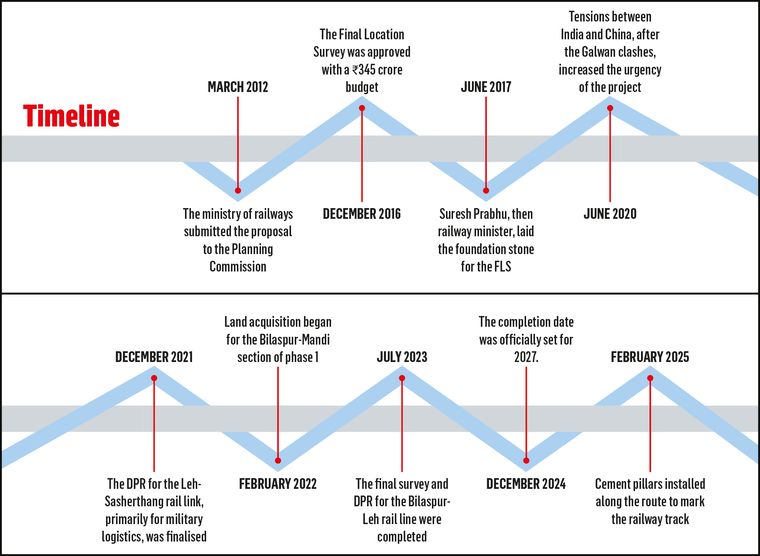Have you imagined travelling on a train to the breathtaking landscapes of Ladakh? That dream will soon become a reality. After the success of the Udhampur-Srinagar-Baramulla Rail Link (USBRL), Indian Railways is now embarking on an even more ambitious venture―a rail line to Ladakh. This new project presents engineering challenges that surpass those faced during the 272-kilometre USBRL, which included remarkable structures like the Chenab Rail Bridge, the world’s highest railway arch bridge, and India’s first cable-stayed railway bridge in Jammu.
Now, the focus shifts to the 489-kilometre Bilaspur-Manali-Leh rail line, which will connect key locations between Bilaspur in Himachal Pradesh and Leh in Ladakh, including Sundernagar, Mandi, Manali, Keylong, Koksar, Darcha, Upshi and Karu. It will significantly improve connectivity and strengthen India’s strategic presence in the region. With an estimated cost of Rs1.31 lakh crore, it will be the most expensive railway project in India’s history.
Beyond its strategic advantages, the rail line will boost tourism and drive regional economic development. Former BJP MP Thupstan Chhewang and two-time BJP MP Jamyang Tsering Namgyal have strongly advocated for the project to be declared a national priority. Namgyal has even suggested that it be directly monitored by the prime minister’s office (PMO). “This project is of immense importance for the defence of India,” Namgyal told THE WEEK. “It will be a game-changer for Ladakh and will end its isolation.” Once operational, he said, the rail line would reduce the cost of essential goods in Ladakh, as raw materials like cement are currently far more expensive due to high transportation costs.
 A file photo of Taglang La, where the world’s highest railway station will be located (5,367m) | Bhanu Prakash Chandra
A file photo of Taglang La, where the world’s highest railway station will be located (5,367m) | Bhanu Prakash Chandra
“A train will also provide Ladakh’s youth with better education opportunities in other states and allow people to travel outside the region for treatment,” he added.
Union Railway Minister Ashwini Vaishnaw, in a written reply to the Lok Sabha during the ongoing Parliament session, confirmed that the Detailed Project Report (DPR) has been finalised. “The Bilaspur-Manali-Leh new line, partly falling with the Union Territory of Ladakh, has been identified as a strategic line by the ministry of defence. The survey for the project has been completed, and the DPR has been prepared,” said Vaishnaw.
 A representational image of Keylong railway station in Himachal Pradesh, which will be underground.
A representational image of Keylong railway station in Himachal Pradesh, which will be underground.
The project was first proposed by the Himachal Pradesh government, with former chief minister Prem Kumar Dhumal highlighting its potential to boost tourism in Himachal Pradesh and Ladakh while facilitating the rapid movement of soldiers and equipment in challenging terrain. A feasibility study was conducted, followed by detailed assessment. A private company won the survey work through a tender process. The proposed route was mapped using aerial LiDAR (Light Detection and Ranging) technology via helicopters, employing Digital Elevation Models (DEM), Digital Terrain Models (DTM), Digital Surface Models (DSM), L-sections, C-sections, and other refined geospatial data crucial for railway engineering.
Currently, construction is underway for the Bhanupli-Bilaspur rail line, marking the first phase of the project. Several tunnels and bridges have already been completed, and work continues on an overbridge near the Govind Sagar Lake in Bilaspur.
According to the initial survey, the project will include 74 tunnels, 124 major bridges, and 396 minor bridges. The entire rail line will have 37 stations, including Keylong, which will be underground. Approximately 52 per cent of the track will pass through tunnels, with the longest extending 27km at Keylong.
Due to extreme weather conditions, the line will not feature sleeper-class coaches. Instead, each coach will be equipped with heaters to combat sub-zero temperatures. Additionally, pressurised cabins, similar to those in aircraft, will be installed to maintain oxygen levels and ensure passenger safety at high altitude. To ensure uninterrupted operations, Indian Railways will implement countermeasures against landslides, cloudbursts, and avalanches, which are common hazards in the region. With half the rail line running underground, adverse weather conditions are expected to have minimal impact. In case of emergencies, authorities estimate the delays will not exceed two to three hours.
Additionally, a 13km extension beyond Leh to the China border is being planned to bolster India’s strategic defence infrastructure. Given the scale and complexity of the project, experts anticipate the costs may escalate. The ministry of defence has approved the extension of the rail line, and Indian Railways has completed the survey.
Ladakh currently lacks year-round connectivity to Himachal Pradesh and the rest of India. The 434km Srinagar-Leh National Highway remains closed for nearly six months a year, isolating Ladakh during winter. Once completed, the rail line will reduce travel time from Delhi to Leh from four days (via road) to two days, dramatically improving accessibility.
A gateway to Siachen Glacier?
The Bilaspur-Manali-Leh rail line is poised to be a historic milestone, offering unparalleled strategic, economic, and socio-cultural benefits. In addition to enhancing national security, boosting tourism, and improving regional connectivity, it could pave the way for an even more ambitious extension to the Siachen Glacier―the world’s highest battlefield.
Currently, Siachen is supplied by road and helicopters in winter. However, after linking Ladakh by rail, authorities may explore extending the railway to the Siachen Base Camp over Khardung La, the world’s highest motorable road.
If realised, this would mark a revolutionary advancement in military logistics and Himalayan railway engineering.





